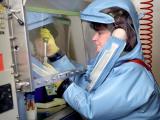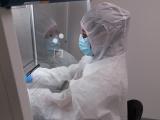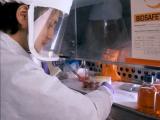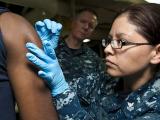Apr 27, 2004 (CIDRAP News) – The University of Minnesota and Texas A&M University will receive a total of $33 million to set up centers to research food contamination threats and foreign animal diseases, the Department of Homeland Security (DHS) announced today.
The two universities have been chosen to lead "Homeland Security Centers of Excellence (HS-Centers) on agro-security," DHS officials said in a news release. Over the next 3 years, Minnesota will receive $15 million for food security research and Texas A&M will receive $18 million to study animal diseases. Both universities will collaborate with several other universities, government agencies, and the food industry.
Agriculture Secretary Ann Veneman stated in the news release, "Research conducted at these two universities will greatly enhance our ability to protect against animal and plant pests and diseases and food pathogens."
The Minnesota-led consortium will be known as the University Center for Post-Harvest Food Protection and Defense (PHFPD). A University of Minnesota news release described the center as "a national consortium of academic, private sector, and government partners including three other universities (Michigan State University, North Dakota State University, and University of Wisconsin–Madison), experts at 12 more universities, independent research facilities, state health and agriculture agencies, professional organizations, agriculture and food industry companies, and private sector consultants." More than 90 investigators are involved, officials said.
Frank Busta, PhD, former chairman of the university's department of food science and nutrition, will serve as director and principal investigator of the new center. The associate director and co-principal investigator is Michael T. Osterholm, PhD, MPH, director of the university's Center for Infectious Disease Research and Policy (CIDRAP), publisher of this Web site.
The DHS statement said the Minnesota center is expected to use its funds "to establish best practices and attract new researchers to manage and respond to food contamination events, both intentional and naturally occurring."
The Texas A&M center will be called the National Center for Foreign Animal and Zoonotic Disease Defense, DHS officials said. The center will study threats to animal agriculture, such as avian influenza, foot-and-mouth disease, and Rift Valley fever.
The Texas researchers will collaborate closely with the US Department of Agriculture's (USDA's) Plum Island Animal Disease Center in New York, according to the DHS. Experts from the University of Texas Medical Branch, University of California at Davis, University of Southern California, and University of Maryland will also be involved. Dr. Neville Clark, director of Texas A&M's Agriculture Bioterrorism Institute, will direct the center.
DHS issued a call for research proposals on food and agricultural security last December and received 23 applications in response, department officials said. Officials from several federal agencies and academic experts reviewed the proposals, and DHS officials subsequently visited seven institutions before selecting Minnesota and Texas A&M.
Minnesota officials said the US food system offers "an array of vulnerable targets for terrorist attack" that could lead to devastating effects on human health and major economic losses.
Busta told CIDRAP News that the new center will assess "both biological and chemical contaminants that could be introduced at any point along the food chain, from production and processing to retail and food service." He said examples of possible contaminants that DHS has identified include anthrax, botulinum toxin, the plant-derived poison ricin, and various chemical agents.
In the Minnesota news release, Busta said, "The breadth and depth of food security knowledge we were able to pull together for this effort is unparalleled."
Osterholm told CIDRAP News, "There was outstanding competition for this program. The other centers put forward some very innovative and thoughtful proposals. We feel appreciative that this was the one DHS decided to go with."
In the university news release, Osterholm commented, "The need to protect against potential deliberate contamination now creates a demand for enhanced capabilities to anticipate, prevent, respond quickly to, and minimize the impact of such attacks." He added that government and the private sector must cooperate to respond to the threat.
Minnesota officials said a group of food industry executives has been working with the university for nearly 2 years to identify security gaps in the nation's food system and to develop plans to address them.
That process has centered on discussions between the university and about 15 companies on a plan for information sharing within the industry concerning food contamination threats, according to Julie Ostrowsky, CIDRAP program manager. She said organizations that were involved include Birds Eye Foods, Burger King, Cargill, Coca-Cola, Fresh Express, General Mills, H-E-B Grocery, Hormel, Jack in the Box, Keystone Foods, Land O'Lakes, the National Corn Growers Association, Sodexho, and SuperValu.
Dane Bernard, vice president of food safety and quality assurance at Keystone Foods in Conshohocken, Pa., said the industry group viewed the information-sharing plan as a potential model that could be used in the evolving federal efforts to protect the food system. He noted that the USDA, the Food and Drug Administration, and trade associations, along with DHS, have all been working on food security plans.
"The Department of Homeland Security decided to fund a particular center, so the work we had already done as to what would work best and what the needs were for information exchange was used by Busta and Osterholm and the planning committee and became an integral part of what was submitted to DHS and was successful," Bernard told CIDRAP News. "And we're pretty excited about it."
Osterholm commented to CIDRAP News, "We feel that one of the assets of our program was the long-standing working relationship with the private sector. Any group that's doing this has to have an active relationship with the private sector. That's very key"
The Minnesota-led consortium proposes to launch a variety of research efforts. Some examples of research goals from a summary of the consortium proposal provided by the university are as follows:
- Development of new techniques to identify and measure the amounts of biological and chemical agents in food
- Development of protocols for rapidly expanding laboratory capacity during a contamination crisis and integrating laboratories with state and national response efforts
- Identification of points in food production where the risk of deliberate contamination is increased
- Development of large-scale methods to quickly dispose of contaminated food and decontaminate facilities
- Identification of best practices to provide accurate and credible information about food contamination to the public.

















